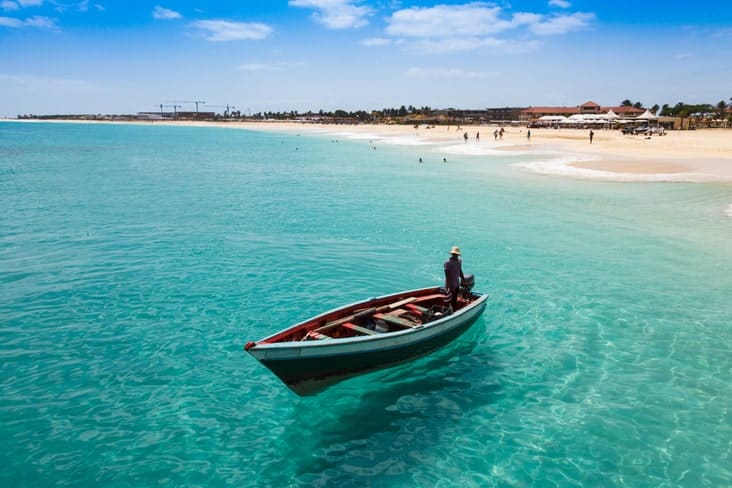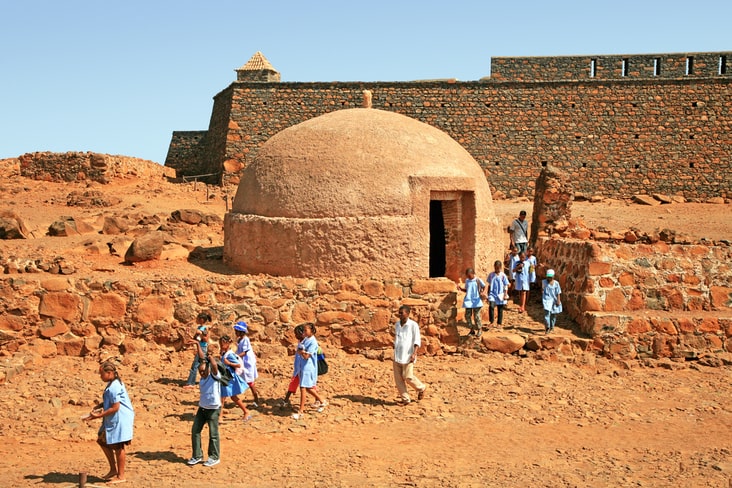The most interesting facts about Cabo Verde, from Africa’s second-most democratic country to a mysterious ghost ship carrying synthesizers.

Fast facts
Official name: Republic of Cabo Verde
Population: 589,451
Area: 4,033 sq km
Capital city: Praia
Major languages: Portuguese, Krioulo (Crioulo/creole)
Major religions: Roman Catholic, Protestant
Time zone: UTC-1 (Cape Verde Time)
– Source: CIA World Fact Book
Interesting facts about Cabo Verde
1. Cabo Verde is a mountainous island nation made up of 10 islands and five islets located off the west coast of Africa.
– Source: BBC News
2. Cabo Verde was uninhabited when the islands were discovered by Portuguese explorers in the 15th century.
– Source: CIA World Fact Book
3. During the 20th century, Cabo Verde was hit by extreme droughts which caused the deaths of around 200,000 people. The events provoked extensive emigration to the extent where today, more people with origins in Cape Verde live outside the country than inside it. The money sent back by emigres and descendants is an important source of foreign currency.
– Source: BBC News

4. From 1462, Portuguese settlers began arriving on the island of São Tiago (Santiago), and the island soon became a trading post for slaves as well as ivory, gold, firearms, rum and cloth.
– Source: BBC News
5. Cabo Verde gained complete independence in 1975, following years of campaigning and a 1974 military coup in Portugal.
– Source: Britannica
6. Cabo Verde gets its name from Cap-Vert (Green Cape) on the Senegalese coast, which is the westernmost point of continental Africa and the nearest mainland to the islands.
– Source: Britannica

7. From 1975, Cabo Verde was officially known by its English translation, Cape Verde. However, in 2013, the country formerly changed its name via the United Nations to the Portuguese name ‘Cabo Verde’.
– Source: United Nations, GOV.UK
8. Cabo Verde was the first landing of Charles Darwin’s famed HMS Beagle voyage. The British naturalist, just 22 at the time, visited the island of Santiago in 1832 where he was particularly impressed by the island’s octopuses, among other specimens.
– Source: Natural History Museum
9. Cabo Verde’s flag has two unequal stripes of blue framing narrower stripes of white and red with a ring of 10 off-centre yellow stars. The stars represent the 10 main islands while blue represents the ocean. The red (effort) and white (peace) represent the process of the founding of the country.
– Source: Britannica

10. Cabo Verde’s capital city, Praia, was named by the Portuguese as Villa de Praia or “Village of the Beach”. It was renamed just Praia in 1974 just before full independence in 1975.
– Source: CIA World Fact Book
11. Morna is the national music of Cabo Verde. The music is a creole fusion of Portuguese, African, Brazilian and Cuban music which is reminiscent of the Blues. The most famous Morna musician was singer Cesária Évora who achieved global recognition for her work.
– Source: The Guardian1, The Guardian2
12. In 1968, a “ghost” ship carrying the latest Korgs, Moogs and Hammond organs was marooned off the Cabo Verde island of São Nicolau. The crew was nowhere to be found and the cargo was distributed to local schools. Overnight, a whole generation of young Cabo Verdeans gained access to the latest electric keyboards which inadvertently inspired the country’s post-independence music explosion several years later.
– Source: The Guardian
13. Cabo Verde has just one UNESCO World Heritage Site, the Cidade Velha, Historic Centre of Ribeira Grande. The town was the first European colonial outpost in the tropics and is famous for its “remains including two churches, a royal fortress and Pillory Square with its ornate 16th-century marble pillar.”
– Source: UNESCO

14. In 2015, Cabo Verde famously pulled off a surprise football (soccer) result over their former colonial masters. They beat the highly-rated Portugal team 0-2 in a friendly match in Estoril, Portugal.
– Source: The Guardian, BBC Sport
16. On the island of Santiago is the Tarrafal Concentration Camp. Here, the Portuguese authorities used to hold and interrogate political prisoners during the 1940s. It was shut down in 1975 and later converted into a museum.
– Source: Lonely Planet, World Monuments Fund (WMF)
15. Cabo Verde is the world’s third-largest nesting site for loggerhead turtles (in terms of numbers of nesting females), after Florida in the USA and Oman. There are believed to be almost 200,000 loggerheads in total.
– Source: The Guardian

17. Grogue is the national drink of Cabo Verde. The local spirit – similar to rum – is distilled from sugarcane and can have an alcohol rate of up to 43%.
– Source: The Independent, Lonely Planet
18. Cabo Verde has Africa’s second-highest level of press freedom, behind only Namibia. It is 27th overall.
– Source: Reporters Without Borders
19. A traditional dish in Cabo Verde is cachupa, a hearty stew made with beans, herbs, cassava and occasionally meat, that is simmered for hours before serving.
– Source: Rough Guides

20. Cabo Verde is the African country most at risk of experiencing natural disasters according to the 2020 World Risk Report, compiled by the United Nations. It is ranked 11th overall.
– Source: World Risk Report 2020 (PDF)
21. Cabo Verde is considered to be Africa’s second-most democratic country after Mauritius. It is ranked 32nd overall according to the Democracy Index compiled by the Economist Intelligence Unit (EIU).
– Source: Economist Intelligence Unit (EIU)
22. Cabo Verde’s highest peak is the active volcano, Pico do Fogo. The 2,829m (9,382ft) conical peak last erupted in late 2014 to early 2015. Despite the obvious risk, farmers continue to grow coffee, fruit and even vineyards on its slopes.
– Source: Lonely Planet

23. Following independence, Cabo Verde initially voted to merge with Guinea-Bissau who had also gained independence from Portugal around the same time. However, following a 1980 coup in Guinea-Bissau, the unity plan was scrapped.
– Source: New York Times, BBC News
24. Cabo Verde’s only indigenous mammal is the long-eared bat. All other mammal species – such as goats, rodents and monkeys – were introduced to the islands.
– Source: Britannica
25. In 2017, Cabo Verde announced its plans to be entirely powered by renewable energy by 2025 – within just eight years. The plan is to use a system of solar, wind and energy storage to achieve the ambitious goal.
– Source: The Independent
26. Cabo Verde is considered to be one of the safest countries in the world to visit. It has been assessed as carrying an ‘insignificant travel security risk’.
– Source: International SOS Travel Risk Map
Every effort has been made to verify these facts about Cabo Verde. However, if you find an error or have any questions, please contact us.